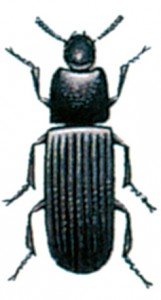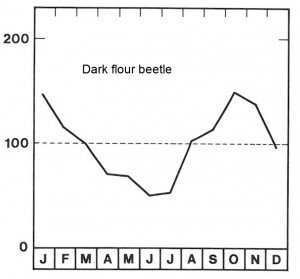

Latin: Tribolium destructor.
A dark brown beetle that is 5-6 mm long and 2 mm wide. The larvae can be up to 10 mm long, plump and wormlike. Both the dark flour beetle and its larvae look like small versions of the yellow mealworm beetle and its larva, the mealworm. This species originates from Africa. The dark flour beetle has glands that can secrete a substance with Lysol or phenol-like odour that sticks to infested goods. Sometimes the smell is so strong that one can determine this type of beetle just by smelling it. If you squeeze it between your fingers the smell is in all cases clear.
A female lays about a thousand eggs in her lifetime. The eggs are placed in flour, grain or other starchy products such as bread, biscuits, macaroni and birdseed. The eggs hatch within a few weeks and the young larvae immediately begin eating. The larvae grow fastest at 28-30 ° C where the larval stage is over within just one month. At room temperature (19-20 ° C), larval development lasts approximately 2 months, while at 15-17 ° C it is extended to approximately 5 months. At temperatures below 13 ° C reproduction and larval development stop completely. The transformation from larva to adult, in the pupal stage, lasts about 2 weeks at 20 ° C. In a typical heated kitchen the development from egg to adult takes more than 3 months. This beetle may get more than 3 years old. The adult beetles often live in the same goods as larvae, but they can also be found in many other food products, and they can survive for months without food.
Since the dark flour beetles move around a lot, they can be difficult to exterminate, because there may be stray individuals all over a building and they will later return to the food. In residential buildings, dark flour beetles can travel along pipes and wires.
The most powerful method used to exterminate these individuals is probably vacuuming followed by spraying with a spray that contains pyrethrin. If you suspect that there are dark flour beetles in goods you can place the goods in a freezer for a couple of days just to be on the safe side. Dark flour beetles are sensitive to low temperatures.




